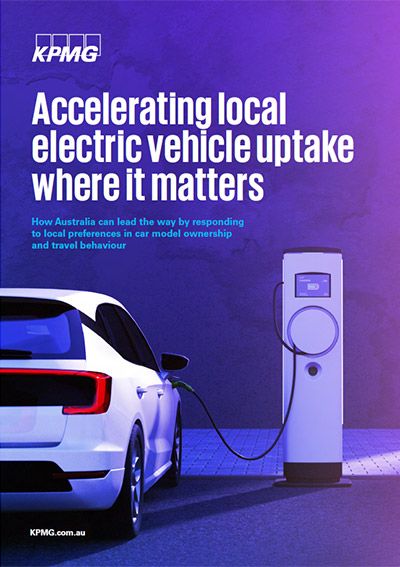Transport emissions are at an all-time high
Decarbonisation is at the top of the list of issues and opportunities for both private and public sector executives. It is now an organisational responsibility and social imperative to act on climate outcomes to achieve our net zero ambitions (along with imminent Commonwealth Government legislation in this space). Vehicles play an important role in terms of contribution to total emissions. As of 2021, almost one fifth of Australia’s carbon emissions came from transportation-related activities.
Electric vehicles (EVs) represent a key pillar in the push towards decarbonisation and governments across Australia are enacting measures to increase the adoption of EVs as part of their net zero action plans. When used in combination with renewable energy, EVs are critical in helping reduce Australia’s carbon footprint.
Car ownership trends and commuting patterns
In three Australian major cities – Sydney, Melbourne and Brisbane – there are clear trends regarding passenger car registrations and commuting patterns:
- People living in the outer suburbs prefer larger more spacious vehicles, whereas people living in the inner-city suburbs prefer smaller vehicles.
- A larger percentage of older vehicles are observed in the outer suburbs than the inner-city suburbs.
- People living in the outer suburbs spend more time and travel further distances commuting than those living in inner suburbs.
These trends highlight the challenges of electric vehicle adoption in outer suburbs where older and higher emitting vehicles are observed. These suburbs will require more incentives to encourage people to replace their old vehicles with EVs.
Beyond EV adoption, having older cars driven further increases vehicle carbon emissions, especially since commuting accounts for about one third of all personal motor vehicle traffic and use.
Electric vehicle uptake to 2031
KPMG has developed our Electric Vehicle Insights and Analytics Platform (EVIAP) that tracks EV volumes at a postcode level. The EVIAP provides an estimate of the annualised EV registrations specific to each postcode in Sydney, Melbourne and Brisbane, taking into consideration the socio-economic characteristics of each postcode as well as the state of the technology at a given point of time.
EV uptake is expected to continue rising in the next decade, however, across the three major Australian cities analysed, electric vehicle adoption in the outer suburbs is predicted to be lower than in the inner suburbs. Out of the three major cities, Sydney is expected to adopt electric vehicles at a faster rate than Melbourne and Brisbane. However, based on our analysis, including on current trends, EV uptake government incentives and vehicle turnover this is likely to have little impact on overall emissions reduction as those in the inner city will transition to EVs first.
The path to greener transport
Using the KPMG EVIAP, we are able to forecast the likely reduction in carbon emission from the EV adoption based on the typical commuting patterns. Our findings show that EV uptake in inner city suburbs with relatively short commuting distance does not provide the emission reduction benefits provided by EV uptake in the outer suburbs where people tend to have longer commuting distance.
To ensure that the adoption of EVs is delivering the necessary results, future policy designs and government incentives need to have a greater focus on incentivising EV adoption beyond inner-city households as targeted decarbonisation effects in outer areas will yield greater emissions savings. To accelerate the adoption of electric vehicles in the low EV uptake areas with longer commuting patterns regions, certain strategies can be applied:
-
Adequate supply of EVs – Ensure popular EV models matched to demonstrated vehicle type preferences are available and easy to access
-
Affordability – Ongoing purchase incentives for lower priced vehicles and/or lower income households would help target uptake in those areas where it will have the largest impact.
-
Targeting long commutes – Subsidising EV commuting, especially in areas with longer commuting distance, will also help encourage EV adoption.
Download our report
Our report, Accelerating local electric vehicle uptake where it matters, aims to contribute to the discussion of EV policy design and implementation going forward by raising awareness of the potential shortfalls and spatial and geographic inequalities present in some of the current policy frameworks. It provides both private and public sectors with new insights into how geographically targeted analysis can better inform the design of policies and social interventions/assistance to address key barriers to EV uptake such as commuting patterns, older vehicle location and social disadvantage may assist a more seamless transition towards net zero.






